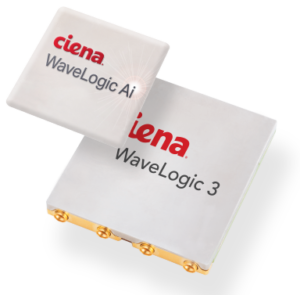 Higher-capacity, larger and more agile networks are needed to stay ahead of the current and oncoming tides of cloud-based services, Virtual Reality (VR), streaming video, gaming and other bandwidth intensive applications. Furthermore, the optical community is working for developing open, disaggregated (in both horizontal and vertical directions), programmable and scalable ways to deploy network capacity efficiently between hyper-scale data centers within dynamic environments. All these requirements lead to multiple, continuous technical developments and breakthroughs, with many of them unveiled just before or at the latest edition of OFC conference (11-15 March 2018 in Los Angeles).
Higher-capacity, larger and more agile networks are needed to stay ahead of the current and oncoming tides of cloud-based services, Virtual Reality (VR), streaming video, gaming and other bandwidth intensive applications. Furthermore, the optical community is working for developing open, disaggregated (in both horizontal and vertical directions), programmable and scalable ways to deploy network capacity efficiently between hyper-scale data centers within dynamic environments. All these requirements lead to multiple, continuous technical developments and breakthroughs, with many of them unveiled just before or at the latest edition of OFC conference (11-15 March 2018 in Los Angeles).
 OFC 2018, which was held this week in San Diego, California, attracted more than 15,500 attendees, 700+ exhibitors from 65 countries, and over 850 peer-reviewed papers in technical sessions (regular and postdeadline). Last year, OFC 2017 recorded 14,500 attendees and 663 exhibitors in Los Angeles. The organizers said OFC has been on a steep growth trajectory over the last three years, increasing in overall square footage by 44% and experiencing a 21% growth in exhibitors and attendees.
OFC 2018, which was held this week in San Diego, California, attracted more than 15,500 attendees, 700+ exhibitors from 65 countries, and over 850 peer-reviewed papers in technical sessions (regular and postdeadline). Last year, OFC 2017 recorded 14,500 attendees and 663 exhibitors in Los Angeles. The organizers said OFC has been on a steep growth trajectory over the last three years, increasing in overall square footage by 44% and experiencing a 21% growth in exhibitors and attendees.
This post includes a selection of the latest optical transport technology news relevant to long-haul, high-capacity applications. Please note that the pick is neither exhaustive, nor free of bias!
64 Gbaud Module for 600G and 1.2T Coherent Transport
NeoPhotonics demonstrated on 12 March at OFC 2018 its 64 Gbaud Coherent Optical Sub-Assembly (COSA). Combined with ultra-narrow linewidth external cavity laser source, the COSA device enables single-lambda 400G signal with 16QAM modulation format, single-lambda 600G signal and two-lambda 1.2T signal using 64QAM modulation format.
Increasing the symbol rate to 64 Gbaud and using higher order modulation, such as 16QAM to 64 QAM, lead to optical signals more sensitive to both amplitude and phase noise since the separation between states is necessarily reduced. This situation therefore requires the ultra-stable, ultra-narrow linewidth laser sources, achieved in the case of NeoPhotonics using an external cavity approach, which results in extremely low frequency phase noise performance.
Note: How do 64 Gbaud symbol rate, 64QAM modulation format and 600G bit rate relate to each other?
- A gross symbol rate of 64 Gbaud corresponds to a net symbol rate of about 50 Gbaud (the extra 14 Gbaud are burnt for overhead and Forward Error Correction coding).
- 66QAM modulation format produces 64 distinct symbols, which require 6 bits per symbols for encoding.
- If one state of optical polarization is modulated by a 64QAM modulating signal at the rate of 64 Gbaud, this produces a net bit rate of 6 x (50 x 109) = 300 Gbit/s.
- Each optical channel is made of two orthogonal states of optical polarization, each of them transporting a 300 Gbit/s data stream; each PM-64QAM optical channel transports therefore 2 x 600 Gbit/s = 600 Gbit/s.
Nokia’s PSE-3 Chipset Leverages Probabilistic Constellation Shaping
 On 5 March 2018 Nokia unveiled its Photonic Service Engine 3 (PSE-3) chipset featuring Probabilistic Constellation Shaping (PCS) that pushes fiber-optic performance close to the Shannon limit to fully exploit fiber capacity. In short, probabilistic constellation shaping is employed to limit the occurrence of high-power symbols (outermost constellation points), so that fiber nonlinearities are reduced, and the optical signal-to-noise ratio is increased for all other symbols (innermost constellation points). More information about this technology can be found here.
On 5 March 2018 Nokia unveiled its Photonic Service Engine 3 (PSE-3) chipset featuring Probabilistic Constellation Shaping (PCS) that pushes fiber-optic performance close to the Shannon limit to fully exploit fiber capacity. In short, probabilistic constellation shaping is employed to limit the occurrence of high-power symbols (outermost constellation points), so that fiber nonlinearities are reduced, and the optical signal-to-noise ratio is increased for all other symbols (innermost constellation points). More information about this technology can be found here.
The PSE-3 chipset, claimed by Nokia to be the first coherent digital signal processor to implement PCS, provides finely adjustable wavelength capacity from 100G to 600G with a single, uniform modulation format, baud rate, and channel size. The capacity adjustment variable is the shaping of the symbols probability distribution on a set of equidistant constellation points.
This capacity tuning goes beyond the limited flexibility of the 100G/200G networks that are prevalent today with today’s coherent technology. In addition to that, uniform baud rate results into uniform channel size, whatever the channel capacity: this greatly simplifies network planning, engineering and operations, and maximizes fiber capacity utilization as well.

Probabilistic shaping relies on the use of a code (called distribution matcher) to gradually vary the probability distribution of the constellation points (from higher probability for the innermost constellation points, to lower probability for the outermost constellation points), resulting in probabilistic shaping of the constellation. By applying probabilistic shaping on a 64QAM signal, low QAM (close to QPSK, leading to 200G carriers) or high QAM (i.e. 64QAM, leading to 600G carriers) signals can be produced by the optical transmitter. This modulation format tunability is illustrated in the figures above and below.

This fine capacity tuning enables to extract the maximal fiber capacity over various optical route distances and optical fiber types, while probabilistic shaping reduces the gap to the fiber capacity Shannon limit due to the two-dimension Gaussian probability mass function for both the in-phase and quadrature components of the constellation symbols.
1.2T Unit for Coriant’s Groove G30 Platform
On 7 March 2018, Coriant introduced a new coherent multiservice unit for its Groove G30 platform. The new 1.2 Tbit/s modular unit is said to leverage advances in integrated photonics and the latest 16nm coherent DSP, and to offer the following performance:
- High density with 9.6 Tbit/s of capacity in a compact and highly modular 1RU;
- Low power consumption with 0.16 watts per gigabit of power;
- Advanced programmability with programmable baud rate (30-70 Gbaud), FEC (0-27%), and modulation format (QPSK to 64QAM) for optimal spectral efficiency;
- Up to 600G single-wavelength transmission for DCI and metro applications (up to 38.4 Tbit/s of capacity per fiber), 400G up to 1,000 km, and 200G up to 4,000 km for long-haul applications.
Infinera’s ICE5 optical engine to drive 2.4T capacity, 600G wavelengths
Infinera unveiled on 12 March 2018 its ICE5 Infinite Capacity Engine for powering its next generation of optical transmission systems. ICE5 integrates Infinera’s fifth-generation photonic integrated circuit with a FlexCoherent Digital Signal Processor (DSP) and fine-grain software control to deliver 100 to 600G wavelength in the industry’s first 2.4 Tb/s optical engine. ICE5 is said to be designed for over 40T on a single fiber within a fraction of a data center rack, increasing capacity up to 65 percent over currently deployed networks while reducing power per transported Gbit/s by 60 percent. It is interesting to note that 6 days before, Nokia claimed that its new PS3-E coherent engine “increased capacity up to 65% over currently deployed networks while reducing power by 60%”.
Infinera Intelligent Transport Network platforms with ICE5 are planned for availability in early 2019.
Up to 600G Bandwidth-Variable Transponders
Fujitsu announced on 12 March 2018 the new 1FINITY T500 and T600 series bandwidth-variable transport blades, a next-generation family of optical transponders designed to meet the demanding needs of global network service providers and data center operators. Based on the latest 16nm CMOS technology developed by NTT Electronics (NEL) in partnership with Fujitsu, the advanced DSP technology delivers dozens of operation modes, including leading 64 Gbaud, 64QAM transmission for 600G wavelengths. Offering variability in data rates, baud rates, modulation rates, channel width and Forward Error Correction (FEC), the new 1FINITY transponders provide optimal transmission performance across a wide range of applications, including Data Center Interconnect (DCI), metro, long-haul and subsea transport.
The new 1FINITY transponders will support both C-band and L-band transmission, allowing full fiber capacity utilization up to 76.8T per fiber pair. Commercial production is expected in the second half of 2018.
Previous Announcements from Other Coherent Suppliers
 Acacia released the AC1200 coherent module on 20 September 2017. This coherent module is based on Acacia’s Pico Digital Signal Processor (DSP) ASIC. Utilizing two wavelengths, with up to 600G capacity each, Acacia’s AC1200 supports transmission speeds of up to 1.2T in a footprint which is 40% less than the size of Acacia’s 5” x 7” module supporting 400G (2 x 200G wavelengths). The AC1200 coherent module is said to support multiple network applications, including Cloud/DCI, metro, long-haul and submarine. In addition to its higher capacity and density, Acacia’s AC1200 coherent module introduces several new features designed to enable network operators to improve efficiency while reducing network costs. Key among these features are:
Acacia released the AC1200 coherent module on 20 September 2017. This coherent module is based on Acacia’s Pico Digital Signal Processor (DSP) ASIC. Utilizing two wavelengths, with up to 600G capacity each, Acacia’s AC1200 supports transmission speeds of up to 1.2T in a footprint which is 40% less than the size of Acacia’s 5” x 7” module supporting 400G (2 x 200G wavelengths). The AC1200 coherent module is said to support multiple network applications, including Cloud/DCI, metro, long-haul and submarine. In addition to its higher capacity and density, Acacia’s AC1200 coherent module introduces several new features designed to enable network operators to improve efficiency while reducing network costs. Key among these features are:
- Tunable Baud Rate – enables continuous baud rate adjustment for optimal utilization of the available spectrum
- Patented Fractional QAM Modulation – provides users with the ability to select very fine resolution of QAM constellations for optimal capacity
- Enhanced Turbo Product Code SD-FEC – offers ultra-high Net Coding Gain (NCG) and enables maximum reach, while maintaining low power dissipation.
 It is almost one year and half ago (on 31 October 2016) that Ciena today unveiled its WaveLogic Ai coherent engine. WaveLogic Ai coherent engine drives 400G single carrier transmission in metro and DCI applications. In regional and long-haul networks, WaveLogic Ai offers 200G and 300G line rates for backbone transmission. And, in submarine networks, WaveLogic Ai coherent engine was designed to provides maximum capacity with ultimate reach at distances up to 14,000 kilometers. Operation at selectable baud rate (35 or 56 Gbaud) and selectable modulation format enable channel capacity tunability. Due to embedded real-time link measurements, WaveLogic Ai coherent module helps determine the optimal capacity for any path across the network and can tune to different capacity levels from 100G to 400G in 50G increments.
It is almost one year and half ago (on 31 October 2016) that Ciena today unveiled its WaveLogic Ai coherent engine. WaveLogic Ai coherent engine drives 400G single carrier transmission in metro and DCI applications. In regional and long-haul networks, WaveLogic Ai offers 200G and 300G line rates for backbone transmission. And, in submarine networks, WaveLogic Ai coherent engine was designed to provides maximum capacity with ultimate reach at distances up to 14,000 kilometers. Operation at selectable baud rate (35 or 56 Gbaud) and selectable modulation format enable channel capacity tunability. Due to embedded real-time link measurements, WaveLogic Ai coherent module helps determine the optimal capacity for any path across the network and can tune to different capacity levels from 100G to 400G in 50G increments.
Unlike last year, no breakthrough announcements were at OFC 2018 about further decrease in optical fiber attenuation or demonstrations of higher capacities for long-haul subsea cable systems. Our September 2017 post (Maximizing Subsea Cable System Capacity: Recent Lab Demos and Field Trials) remains a good source of information for getting a quick understanding of where the industry is at with high-capacity subsea transport over long distances. Focusing on transmission equipment connected at the ends of subsea cable systems, the clear trends are increase in the channel capacity and the in the number of operational modes that are made available to operators (selectable baud rate, selectable modulation format, selectable FEC overhead, tunable capacity). With some commercial transmission equipment, the number of operational modes can range from 20 to 30! This flexibility enables to reduce the gap to the Shannon limit and to maximize the fiber capacity, whatever the length of the optical route.
For comments or questions, please contact us.

